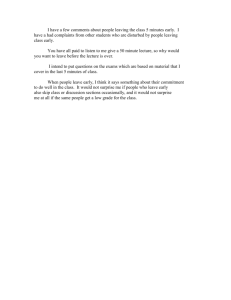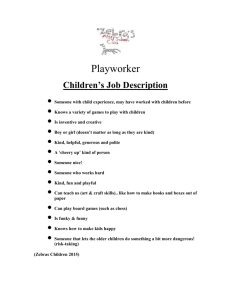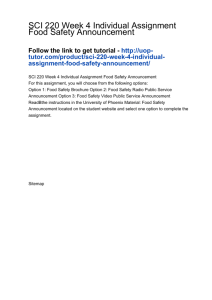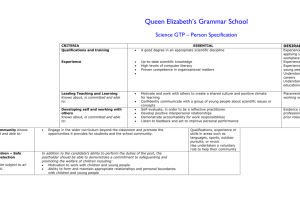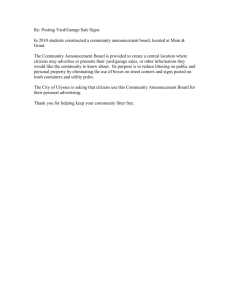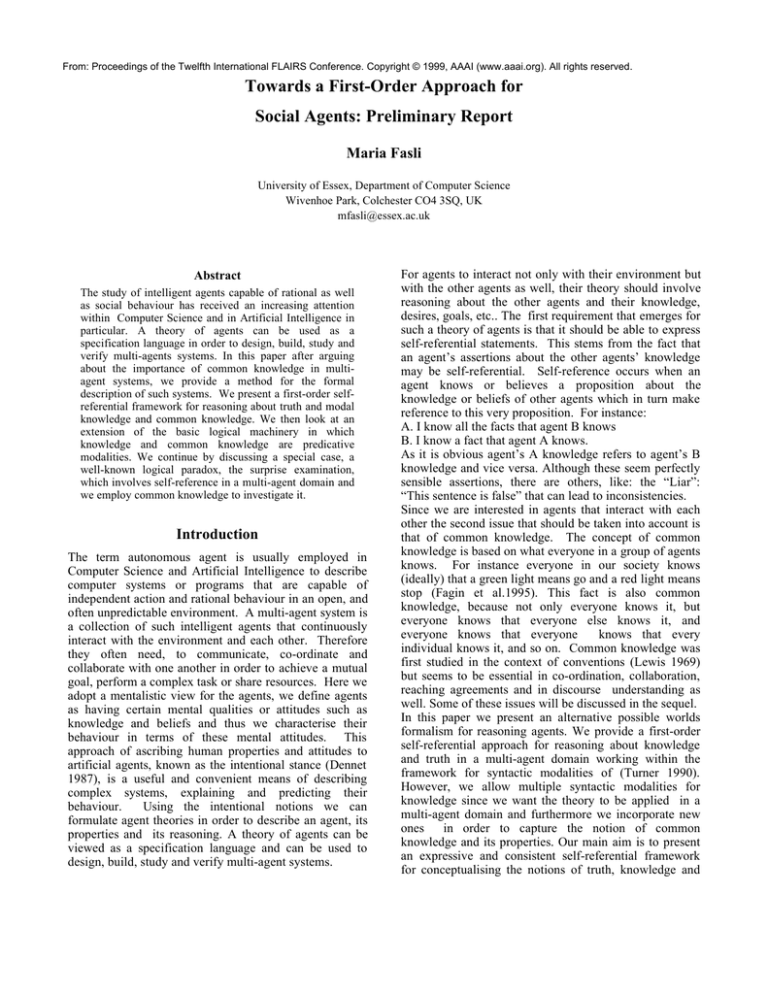
From: Proceedings of the Twelfth International FLAIRS Conference. Copyright © 1999, AAAI (www.aaai.org). All rights reserved.
Towards a First-Order Approach for
Social Agents: Preliminary Report
Maria Fasli
University of Essex, Department of Computer Science
Wivenhoe Park, Colchester CO4 3SQ, UK
mfasli@essex.ac.uk
Abstract
The study of intelligent agents capable of rational as well
as social behaviour has received an increasing attention
within Computer Science and in Artificial Intelligence in
particular. A theory of agents can be used as a
specification language in order to design, build, study and
verify multi-agents systems. In this paper after arguing
about the importance of common knowledge in multiagent systems, we provide a method for the formal
description of such systems. We present a first-order selfreferential framework for reasoning about truth and modal
knowledge and common knowledge. We then look at an
extension of the basic logical machinery in which
knowledge and common knowledge are predicative
modalities. We continue by discussing a special case, a
well-known logical paradox, the surprise examination,
which involves self-reference in a multi-agent domain and
we employ common knowledge to investigate it.
Introduction
The term autonomous agent is usually employed in
Computer Science and Artificial Intelligence to describe
computer systems or programs that are capable of
independent action and rational behaviour in an open, and
often unpredictable environment. A multi-agent system is
a collection of such intelligent agents that continuously
interact with the environment and each other. Therefore
they often need, to communicate, co-ordinate and
collaborate with one another in order to achieve a mutual
goal, perform a complex task or share resources. Here we
adopt a mentalistic view for the agents, we define agents
as having certain mental qualities or attitudes such as
knowledge and beliefs and thus we characterise their
behaviour in terms of these mental attitudes. This
approach of ascribing human properties and attitudes to
artificial agents, known as the intentional stance (Dennet
1987), is a useful and convenient means of describing
complex systems, explaining and predicting their
behaviour.
Using the intentional notions we can
formulate agent theories in order to describe an agent, its
properties and its reasoning. A theory of agents can be
viewed as a specification language and can be used to
design, build, study and verify multi-agent systems.
For agents to interact not only with their environment but
with the other agents as well, their theory should involve
reasoning about the other agents and their knowledge,
desires, goals, etc.. The first requirement that emerges for
such a theory of agents is that it should be able to express
self-referential statements. This stems from the fact that
an agent’s assertions about the other agents’ knowledge
may be self-referential. Self-reference occurs when an
agent knows or believes a proposition about the
knowledge or beliefs of other agents which in turn make
reference to this very proposition. For instance:
A. I know all the facts that agent B knows
B. I know a fact that agent A knows.
As it is obvious agent’s A knowledge refers to agent’s B
knowledge and vice versa. Although these seem perfectly
sensible assertions, there are others, like: the “Liar”:
“This sentence is false” that can lead to inconsistencies.
Since we are interested in agents that interact with each
other the second issue that should be taken into account is
that of common knowledge. The concept of common
knowledge is based on what everyone in a group of agents
knows. For instance everyone in our society knows
(ideally) that a green light means go and a red light means
stop (Fagin et al.1995). This fact is also common
knowledge, because not only everyone knows it, but
everyone knows that everyone else knows it, and
everyone knows that everyone
knows that every
individual knows it, and so on. Common knowledge was
first studied in the context of conventions (Lewis 1969)
but seems to be essential in co-ordination, collaboration,
reaching agreements and in discourse understanding as
well. Some of these issues will be discussed in the sequel.
In this paper we present an alternative possible worlds
formalism for reasoning agents. We provide a first-order
self-referential approach for reasoning about knowledge
and truth in a multi-agent domain working within the
framework for syntactic modalities of (Turner 1990).
However, we allow multiple syntactic modalities for
knowledge since we want the theory to be applied in a
multi-agent domain and furthermore we incorporate new
ones
in order to capture the notion of common
knowledge and its properties. Our main aim is to present
an expressive and consistent self-referential framework
for conceptualising the notions of truth, knowledge and
common knowledge. However, due to space limitations
we do not present the model theory and the theorems are
stated without proof. The structure of the paper which
consists of four subsequent sections is as follows. In the
next section we informally establish the necessity of
common knowledge in a multi-agent system. The
following section firstly describes the basic logical
machinery that supports the notions of truth and modal
knowledge and common knowledge and then an extension
of the framework in which knowledge and common
knowledge are treated as syntactic modalities. We
continue by discussing a special case, the surprise
examination, using common knowledge as the new means
of investigating it. A summary and a brief discussion of
our findings is then provided and the paper ends with the
conclusions and a pointer to future work.
The Need for Common Knowledge
In this section we will embark on a more detailed
discussion of the concept of common knowledge and we
will argue about its need in a multi-agent system. Recall
from the discussion above that common knowledge is
based on what everyone in a group of agents knows and
that it was first discussed by (Lewis 1969) in his
philosophical study of conventions. Although we are not
going to engage in a sociological analysis of conventions
and how they are formed, nevertheless we have to
mention here that conventions and social norms are
regularities in behaviour. A convention is nothing more
than a group prescription to do or not to do given actions
under certain circumstances, it is a co-operative social
behaviour and everyone belonging to a certain group or
community has to conform to it. What is important in the
formation of conventions and social norms however, is
the concept of common knowledge.
In order for
something to be a convention in a group, everyone must
be aware of the conditions of the convention, and
everyone must know that every other member of the
group knows that and that everyone is willing to conform
to this convention. In other words everyone in the group
must have common knowledge of the convention.
Structured groups of human agents like societies,
communities and organisations, operate according to
certain predetermined authority relationships and social
norms. Once an agent enters into a community he is given
a specific role which entails a set of rights and
obligations. Each member of the group knows its place
and acts accordingly and furthermore each knows the
implications of exercising rights and braking
commitments. These authority mechanisms rely on the
obedience of the addressees and their behaviour, and
enable the whole group to act effectively and efficiently.
In such a structured community the notion of common
knowledge naturally arises. For instance, the leader of
such a group has a certain predetermined authority and
this is common knowledge among all the members of the
group. All members also know that they are obliged to
carry out certain tasks and obey the leader and this is
profoundly common knowledge. However it seems
reasonable to suggest that agents in artificial societies or
in multi-agent systems with build-in or with the ability to
form, authority relationships and groups should have
common knowledge of the whole structure, as well of
their role in it, and the rights and obligations regarding
themselves and the other agents.
An ordinary way of acquiring common knowledge is
through communication. Announcements made in public
are sources of common knowledge. The purpose of the
speaker is to make her intentions, goals, preferences etc.
known to a group of other agents as a whole, that is she
provides common knowledge.
The content of the
announcement can then be used by each of the members
individually and as a group as well, in order to make
decisions, plans or take action. Simple speech acts
between two or more agents, exchanging information can
be the source of common knowledge as well, on the
grounds that the agent supplying common knowledge is
trustworthy and reliable. From now on and throughout this
paper we assume that we are dealing with rational,
truthful and sincere agents, who have no intention of
deceiving one another or supply false information.
Common knowledge is also relevant in discourse
understanding and in the use of a specific language among
a population since grammar rules and word meaning are
considered common knowledge. Consider the case of a
new expression added to the language. In order to use
this expression a group must have common knowledge of
it, how it is used, what it means and that everyone knows
its meaning and how to use it as well.
In a number of applications such as agreements, coordination and collaboration, common knowledge seems
to be relevant as well. For instance suppose that two
agents A and B need to agree on some statement x. It is
reasonable to suggest that if the two agents agree on x
then each of them knows that they have agreed on x. This
is a key property of agreement: each of the agents must
know about the agreement and he must also know that
every other participant in the agreement knows about it.
Thus agreements always presuppose common knowledge
among all the agents involved. In co-ordination situations
each agent needs common knowledge for example of the
schedule of actions to be performed. In cases such as the
co-ordinated attack where common knowledge cannot be
attained, co-ordination becomes difficult if not at all
impossible (Fagin et al.1995).
But how does common knowledge affect an agent’s social
behaviour and influences an agent’s decisions, future
actions and goals? For instance, in the case where an
agent belongs to a certain structured group, community or
organisation, the agent has to adopt social commitments
and must undertake obligations and rights. But a socially
committed agent to a group or another agent, loses some
of its autonomy in order to adapt to the organisational
constraints. Therefore an agent having now common
knowledge of certain restrictions may need to modify his
behaviour to conform to these restrictions. His goals and
future plans and actions may be in conflict with the
constraints and requirements of the group and thus may
need modifications and alterations. Perhaps some of them
need to be abandoned completely. Common knowledge is
not an abstract definition but a key concept, a basic and
active ingredient of an agent’s reasoning process and
affects and guides the agent’s social behaviour .
The Logical Framework
In this section we present an alternative possible worlds
formalism for agents. Our logical machinery is based on
the framework proposed in (Turner 1990) which we
extend further by adopting the approach of (Fagin et
al.1995) towards common knowledge.
Our language / is based on a First Order language and
apart from the standard connectives and quantifiers it also
includes: a) Three predicate symbols T, F and = for truth,
falsity and equality respectively. b) Three modal operators
Ki, EX, CX, for what an agent knows, what everyone knows
and what is common knowledge in a group of agents. c) A
set of variables V and a set of predicate symbols P.
Terms are: i) Constants, ii) Variables, iii) wffs can be
treated as terms in the language in order to allow circular
reference. Thus if A(y1, y2,..,yn) is a wff and y1, y2,..,yn are
free variables then (tA,y1, y2,..,yn) is a term. (In what
follows we write A where no confusion can arise.)
Inductive definition of wffs:
i)If t and t’ are terms then t= t’, T(t) and F(t) are wffs
ii)If x is a variable and A and B are wffs, so are ¬A, A∧
B, A∨B, A⇔B, A⇒B, ∀xA, and ∃xA
iii)If A is a wff then Ki (A) , EX(A) and CX(A) are wffs.
A model for the logical language / is a tuple
0=<:,Ki,',T,F> where: : is a set of possible worlds,
Ki, is a set of accessibility relations, ' is the multi-agent
domain of individuals, T is the extension of the truth
predicate (that is T: '×:→{0,1}) and F is similarly the
extension of the false predicate. We require the domain of
individuals to be constant and Cartesian closed, and each
individual constant to be a rigid designator.
The weakest logic that we can have for Truth, modal
knowledge and common knowledge is DTm :
k. T(A⇒B)⇒(T(A)⇒T(B))
d. T(A)⇒¬ T(¬A)
bar ∀xT(A)⇒ T(∀xA)
Nec if DTm−A then DTm −T(A)
K. Ki(A⇒B)⇒( K i(A)⇒K i(B))
D. K i(A)⇒¬ K i(¬A)
BAR ∀xK i(A)⇒ K i(∀xA)
NEC if DTm−A then DTm −K i(A)
E. EX(A)⇔∧ i ∈ X Ki (A)
k
C. CX(A)⇔EX (A) for k=1,2,…..
IR. If A⇒EX(A∧B) then A⇒CX(B)
We can strengthen the logic in two ways i) by adding
stronger axioms for Truth and therefore weaken the
necessitation rule in order to obtain consistency, or ii) by
adding stronger axioms for modal knowledge. Let X be
any subset of the standard axioms for truth {t,s4}:
t. T(A)⇒A
s4. T(A)⇒T(T(A))
Let Y be any subset of the standard modal axioms for
knowledge {T,S4,S5} given below:
T. Ki(A)⇒A
S4. K i(A)⇒ K i(Ki(A))
S5. ¬K i(A)⇒ K i(¬K i(A))
Let us call the logic D[X,Y] the logic which comprises of
the aforementioned DTm logic and the sets of axioms Y
and X together with the rules:
Neca. if D[Y] −A then D[X,Y] −T(A)
Necb. if D[X,Y] −A then D[X,Y] −Ki (A)
Theorem 1.
D[X,Y] logics are consistent systems of truth and modal
knowledge and common knowledge.
Let us extend the language / to / by adding three new
predicates KNOWi, EKX and CKX for expressing
knowledge, what everyone in a group knows and common
knowledge respectively. Since it is well known that a
direct treatment of knowledge as a predicate can result in
inconsistency, we are going to use an alternative approach
here in order to obtain consistency on the one hand, and
strong enough logics on the other. In this approach,
following (Turner 1990) the knowledge predicate is
defined as follows: KNOWi (A) = def Ki(T(A))
Now the central question is what are the available logics
to us. The weakest logic is DTK:
k. T(A⇒B)⇒(T(A)⇒T(B))
d. T(A)⇒¬ T(¬A)
bar ∀xT(A)⇒ T(∀xA)
Nec if DTK−A then DTK −T(A)
K. KNOWi(A⇒B)⇒(KNOW i(A)⇒KNOW i(B))
D. KNOW i(A)⇒¬ KNOW i(¬A)
BAR ∀xKNOW i(A)⇒ KNOW i(∀xA)
NEC if DTK−A then DTK −KNOW i(A)
Let X be the same set as in the simple modal case and Y
be any subset of the axioms for knowledge {T,S4}:
T. KNOWi(A)⇒A
S4. KNOW i(A)⇒KNOW i(KNOWi(A))
Let us call DTK[X,Y] the logic which comprises of the
aforementioned DTK logic and the sets of axioms Y and X
together with the rules:
NecA. if DTK−A then DTK[X,Y] −T(A)
NecB. if DTK−A then DTK[X,Y] −KNOWi (A)
Theorem 2.
DTK[X,Y] logics are consistent logics of truth and syntactic
modality.
The following axiom connecting truth and knowledge can
be consistently added to the aforementioned logics.
T(KNOWi(A))⇔KNOW i(T(A))
The predicate EKX can be defined as a syntactic modality
as follows: EKX (A) = def EX(T(A))
and similarly CKX as : CKX(A) = def CX(T(A))
The properties of these two new predicates reflect the
properties of the respective modal operators:
E. EKX(A)⇔∧ i ∈ X KNOWi (A)
k
C. CKX(A)⇔EKX (A) for k=1,2,……
IR. If A⇒EKX(A∧B) then A⇒CKX(B)
Theorem 3.
The DTK[X,Y] logics together with the above axioms for
the EKX and CKX predicates, are consistent.
Consistency for all the above logics can be obtained by
using the semantic theory of truth of (Gupta 1982,
Herzberger 1982) relativized to possible worlds.
So far all the predicates have taken just a single argument
denoting a wff of the language. We now relativize these
notions to specific agents in order to truly allow a multiagent domain. Thus the predicate KNOW is extended so
as to take 2 arguments, namely an agent and a wff:
KNOW(i,A) and the predicates EK and CK are extended
similarly as follows: EK(X,A) and CK(X,A) where X
denotes the group of agents that the predicates refer to.
Common Knowledge and the Surprise
Examination
In the preceding sections we mentioned the notion of selfreference and the fact that sometimes it can lead to
inconsistencies. We will examine such a situation here, a
logical paradox, known as the surprise examination
(Montague and Kaplan 1959), which involves selfreference and arises in a multi-agent environment. The
situation can be told the following way:
The teacher tells the class that some time during next
week she will give a surprise examination. She will not
say on which day for she says it is to be a surprise. Is it
possible for the teacher to give a surprise exam?
A student now can reason as follows. The exam cannot
take place on Friday. Because if it hasn’t taken place on
any of the previous days then on Thursday the student will
know that it will take place on Friday. If the student
knows the day then it cannot be a surprise, and thus the
exam day cannot be Friday. But the exam day cannot be
Thursday either. Because if the exam hasn’t taken place
on any of the previous days and having already excluded
Friday, the student thinks that the only possible day left is
Thursday. But again if he knows the day then it cannot be
a surprise and so the exam day cannot be Thursday.
Using the same line of reasoning the student can eliminate
the rest of the days as well and come to the conclusion
that there is not going to be an exam in the next week.
The paradox has been formalised in a number of ways in
the literature and (Sainsbury 1995) contains a very
thorough discussion. The teacher’s announcement is
indeed self-referential. She states on the one hand that
there is going to be an exam some time next week and on
the other that based on her very announcement (this is
where self-reference occurs, the teacher refers to her own
announcement) the students will not know the day of the
exam, it will come as a surprise. Although the surprise
examination has been characterised as a paradox, we
believe that other important issues as well, like the means
of communication, social relationships and moral
obligations which arise, have not been sufficiently
explored. As we are going to show in all these issues the
concept of common knowledge is crucial and can help us
investigate it.
Communication among any members of the group is
achieved through announcements and speech acts, which
is a way of making someone’s plans and intentions
known. Recall from the second section that the content of
public announcements is considered to be common
knowledge among the speaker and the audience after the
announcement is made. Since the announcement is made
in public this creates a moral obligation as well. The
teacher’s declaration of her intentions can be interpreted
as a promise, or a commitment to the students. We
prefer to keep our promises because we do not want to
destroy our reputations for not keeping promises.
Keeping one’s promises is a convention and this in fact is
common knowledge among the members of our society.
In addition the surprise examination takes place among
the members of a specific organised group, a class. In it
the students and the teacher have separate roles each with
respective rights and obligations. Furthermore the teacher
has a certain kind of authority which is well known and
accepted among the other members of the group.
Taking into account the whole setting of the surprise
examination and from the discussion above we can
positively say that common knowledge arises in this case.
A student belongs to a structured group, in which the
teacher has an authoritative position which gives her the
right to make decisions and the students are obliged to
follow them. This is one reason for the student to take the
teacher’s announcement seriously. Moreover the teacher
is considered to be truthful and sincere and this in fact is
part of her obligations and commitments towards the
class. Furthermore her intentions have taken the form of
a promise, a strong social commitment and this is another
reason for the student to believe the teacher’s
announcement. Going even further, if the student tries to
model the teacher’s reasoning he will be able to see that
what the teacher had promised to do is indeed achievable.
Therefore it is quite reasonable for the student to conclude
that having common knowledge of the teacher’s
announcement, he has common knowledge of the fact that
he is not going to know the exact day of the exam, and
this conclusion is supported by the above argumentation.
Obviously, in order to fully analyse the surprise
examination we would need not only knowledge and
common knowledge, but intentions, goals, commitments,
obligations and actions. However here we are going to
restrict our formal analysis to the use of common
knowledge only, since our theory does not fully account
for all the issues involved in this complex situation.
The basic idea behind our formalisation of the surprise
examination is that the teacher’s self-referential
announcement does not include the kind of information
needed by the class to estimate the exact day of the exam.
Therefore knowing the announcement does not imply
knowing the day of the exam. These intuitions now take
the following form: A:A1 ∧(Know(C,A)⇒¬ Know(C,B))
where A:“I will give you an exam next week and based on
the knowledge of this announcement, you will not know
the exact day of the exam”, A1: “I will give you an exam
next week”, B: “The exact day of the exam”, and A1 and
B can be written as first order formulas of our language.
For simplicity we do not write the first argument of the
predicates that refers to the class. With the introduction of
common knowledge, the fact that the class will not know
the exact day of the exam becomes common knowledge.
1. A
Assumption
2. EK(A)
Everyone knows
3. EK(A1 ∧(KNOW(A)⇒¬KNOW(B)))
2, def. of A
4. EK(A1)∧EK(KNOW(A)⇒¬KNOW(B))
3,Thm of
DTK[X,Y]
5. EK(KNOW(A)⇒¬KNOW(B))
4, ∧-elimination
6. EK(KNOW(A))⇒EK(¬KNOW(B)) 5,Thm DTK[X,Y]
7. CK(KNOW(A))⇒ CK(¬KNOW(B)) A was public
thus it is common knowledge as well as (¬KNOW(B))
We conclude that common knowledge of the
announcement implies that it is common knowledge that
the class will not know the exact day of the exam. The
class is in fact aware of their lack of knowledge of the
examination day. This result is quite different from those
found in the literature so far (Sainsbury 1995). There is
no good reason for rejecting the announcement as a false
one since the teacher is considered truthful and has no
intention of deceiving the class. It is not logical either to
conclude that the class does not know the announcement.
The fact that the announcement is made in public puts the
students in a very special situation, in which all of them
know that the announcement is true and that they are in
this situation, the announcement is common knowledge.
reference.
Once the mechanism for implementing
circular reference is added to modal logic, the whole
approach runs into problems and modal theories suffer
from the same drawbacks as syntactic theories (Perlis
1985). Our approach yields consistent self-referential
logics for truth, knowledge and common knowledge
which are not too weak to work with in which statements
like the “liar” and the “knower” (Montague and Kaplan
1959) can be blocked. We have also formalised the
surprise examination based on our intuitions about the
teacher’s announcement as a self-referential statement,
without however changing the meaning of the original
statement, and we demonstrated how common knowledge
can be employed to investigate it. There are a number of
possible avenues for future development of this model.
Firstly the notion of time can be incorporated into the
model and the relation between time, common knowledge
and action can be studied. Secondly the model can be
extended to a K(B)DI (Rao and Georgeff 1991) model and
enriched by incorporating intentions and desires as new
syntactic modalities. However, while the ideas in this
paper may be conceptually appealing, considerable work
remains to be done to analyse the utility of the approach
in more complex situations.
Acknowledgements
I would like to thank Ray Turner and the reviewers for
their helpful comments on an earlier draft of this paper.
This research has been supported by GSSF grant 189/96.
References
Concluding Remarks.
This paper has presented a method for the formal
description of multi-agent systems. Although this work
leaves many unanswered questions, we believe it is a first
step towards the direction of a first order theory of social
agents with self-referential capabilities. A first order
language has been presented in which the concepts of
truth, knowledge and common knowledge have been
formalised based upon the framework for syntactic
modalities set up by (Turner 1990). A number of
properties have been introduced as axioms of a theory of
agency concerning the aforementioned concepts. It is
argued that the intuitions captured in this model provide a
flexible way of describing agents and the kind of
reasoning involved in a multi-agent environment. The
framework is quite flexible and for instance, instead of
knowledge we can formalise the weaker notion of belief.
Our model presents the following advantages when
compared with other approaches. Firstly we use first
order logic which offers more expressive power than
classical modal logic. Furthermore, although the formal
counterpart of first order theories, standard modal logics,
offer another possible and attractive way for formalising
knowledge and belief, they lack the characteristic of self-
Dennet D.C. 1987. The Intentional Stance. Cambridge, Mass.:
The MIT Press.
Fagin et al. 1995. Reasoning about knowledge. Cambridge,
Mass.: The MIT Press.
Gupta H. 1982. Truth and Paradox. Journal of Philosophical
Logic 11:1-60.
Herzberger H. 1982. Notes on Naïve Semantics. Journal of
Philosophical Logic 11:61-102.
Lewis D. 1969. Convention, A Philosophical Study. Cambridge,
Mass.: Harvard University Press.
Montague R. And Kaplan D. 1960 A Paradox Regained. Notre
Dame Journal of Symbolic Logic 1:79-90.
Perlis D. 1985. Languages with Self-reference I: Foundations.
Artificial Intelligence 25:301-322.
Rao A. and Georgeff M. 1991. Modelling Rational Agents
nd
within a BDI-Architecture. In Proceedings of the 2
International Conference on Principles of
Knowledge
Representation and Reasoning. San Mateo, Calif.: Morgan
Kaufmann Publishers.
Sainsbury R.M. 1995. Paradoxes. Cambridge, England:
Cambridge University Press.
Turner R.1990. Truth and Modality for Knowledge
Representation. Cambridge, Mass.: The MIT Press.

